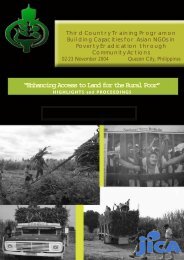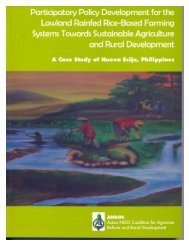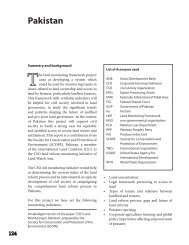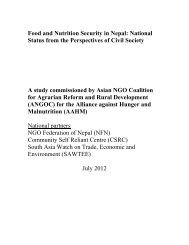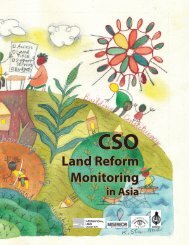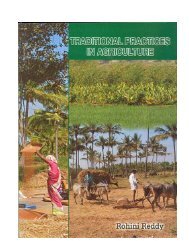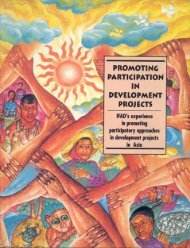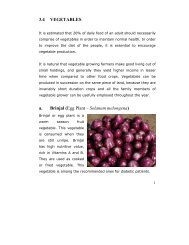Securing the Right to Land FULL - ANGOC
Securing the Right to Land FULL - ANGOC
Securing the Right to Land FULL - ANGOC
Create successful ePaper yourself
Turn your PDF publications into a flip-book with our unique Google optimized e-Paper software.
purchasers. Similarly, <strong>the</strong> Eleventh Plan (2007-2012) document<br />
refers <strong>to</strong> contract farming as ano<strong>the</strong>r mechanism whereby <strong>the</strong><br />
private corporate sec<strong>to</strong>r can establish linkages between farmers<br />
and markets, with adequate safeguards for farmers’ interest and<br />
dispute resolution.<br />
Legal and Policy Framework for<br />
Access <strong>to</strong> <strong>Land</strong> and Tenurial Security<br />
The Constitution of India<br />
The Constitution of India guarantees fundamental rights. Equity<br />
and social justice are <strong>the</strong> basic tenets of <strong>the</strong> Constitution.<br />
“<strong>Land</strong> <strong>to</strong> <strong>the</strong> tiller” is <strong>the</strong> guiding principle of India’s land reforms<br />
program. But <strong>the</strong> right <strong>to</strong> property is not provided for in Part III<br />
of <strong>the</strong> Indian Constitution. In o<strong>the</strong>r words, it is not a justiciable<br />
right. Never<strong>the</strong>less, <strong>the</strong> concept of equity is built in<strong>to</strong> India’s<br />
Constitution. For instance, <strong>the</strong> 44 th Amendment <strong>to</strong> <strong>the</strong> Constitution,<br />
altered Article 38 <strong>to</strong> introduce <strong>the</strong> following clause:<br />
The State shall, in particular, strive <strong>to</strong> minimize <strong>the</strong> inequalities<br />
of income, and endeavour <strong>to</strong> eliminate inequalities<br />
in status, facilities and opportunities, not only amongst<br />
<strong>the</strong> individuals but also among groups of people residing in<br />
different areas or engaged in different vocations.<br />
Article 38 falls within <strong>the</strong> Directive Principles of State Policy<br />
(Articles 36 <strong>to</strong> 51) that are non-justiciable but outline <strong>the</strong><br />
philosophy that will guide policy, in <strong>the</strong> hope that <strong>the</strong>se provisions<br />
will one day become law.<br />
Article 39 of <strong>the</strong> Constitution provides that <strong>the</strong> ownership and<br />
control of <strong>the</strong> material resources of <strong>the</strong> community should be<br />
distributed in such a way that <strong>the</strong> common good is best served,<br />
and that <strong>the</strong> economic system does not result in <strong>the</strong> concentration<br />
of wealth and <strong>the</strong> detriment of <strong>the</strong> means of production.<br />
Thus, <strong>the</strong> equitable distribution of assets and social justice are<br />
given emphasis in <strong>the</strong> Indian Constitution. The latter also stipulates<br />
that States [must] direct policies <strong>to</strong> ensure that all citizens<br />
have <strong>the</strong> right <strong>to</strong> adequate means of livelihood and that all community<br />
resources be distributed so as <strong>to</strong> serve <strong>the</strong> common good.<br />
It is important <strong>to</strong> note that <strong>the</strong> Constitutional makers also<br />
gave each State, ra<strong>the</strong>r than <strong>the</strong> Central Government, <strong>the</strong> exclusive<br />
power <strong>to</strong> make laws with respect <strong>to</strong> land, including<br />
land reform laws.<br />
RIDING THE CREST OF PEOPLE’S MOVEMENTS<br />
83<br />
State <strong>Land</strong> Reform Laws<br />
Every State has enacted its own land reform laws on subjects<br />
and issues as follows:<br />
Abolition of Zamindari system <strong>to</strong> eliminate intermediaries;<br />
Ceiling on land holdings <strong>to</strong> do away with uneven distribution<br />
of land and for redistribution of ceiling-surplus land<br />
among <strong>the</strong> landless;<br />
Tenancy reforms <strong>to</strong> ensure security of tenure for peasants,<br />
regularization of rent/revenue, and ownership;<br />
Regulation of share-cropping <strong>to</strong> safeguard <strong>the</strong> interest of<br />
<strong>the</strong> share-croppers;<br />
Protection against alienation of land belonging <strong>to</strong> weaker<br />
sections such as SCs and STs;<br />
Consolidation of fragmented land holdings;<br />
Provision of homestead <strong>to</strong> <strong>the</strong> landless households;<br />
Providing government land <strong>to</strong> <strong>the</strong> landless on long-term<br />
lease including tree-lease; and<br />
Statu<strong>to</strong>ry minimum wages <strong>to</strong> agricultural labor.<br />
These land reform laws were included in <strong>the</strong> Ninth Schedule of<br />
<strong>the</strong> Constitution, which was introduced in <strong>the</strong> very first amendment<br />
in 1951 as a means of immunizing certain laws against<br />
judicial review.<br />
Forest <strong>Right</strong>s Act of 2006<br />
The Scheduled Tribes and o<strong>the</strong>r Traditional Forest Dwellers (Rec-<br />
ognition of Forest <strong>Right</strong>s) Act of 2006 recognizes and gives forest<br />
rights, as well as rights <strong>to</strong> occupy forest land, <strong>to</strong> STs and<br />
o<strong>the</strong>r traditional forest dwellers and provides <strong>the</strong> framework for<br />
recording forest rights. There are, however, several aspects of<br />
<strong>the</strong> law that leave room for doubt as <strong>to</strong> how effective it would<br />
be in terms of rectifying what <strong>the</strong> Government of India has conceded<br />
as “his<strong>to</strong>rical injustices” <strong>to</strong> <strong>the</strong> forest dwelling STs and<br />
o<strong>the</strong>r traditional forest dwellers. Until <strong>the</strong>se discrepancies are<br />
addressed and <strong>the</strong> loopholes in <strong>the</strong> Act are removed, <strong>the</strong> land<br />
rights of forest dwelling communities will remain insecure.<br />
Constitutional and Legal Provisions for Tribal<br />
<strong>Land</strong> <strong>Right</strong>s<br />
Article 244 of <strong>the</strong> Constitution in Schedule Five makes it manda<strong>to</strong>ry<br />
for <strong>the</strong> State <strong>to</strong> ensure <strong>the</strong> <strong>to</strong>tal prohibition of immovable<br />
property <strong>to</strong> any person o<strong>the</strong>r than a tribal group and <strong>to</strong> protect<br />
<strong>the</strong> possession, title and interests of <strong>the</strong> tribals. The provisions<br />
under Schedule Five of this clause are not only applicable <strong>to</strong> <strong>the</strong><br />
administration of areas designated as “scheduled areas” but also<br />
<strong>to</strong> those assigned <strong>to</strong> original tribal owners.<br />
ASIAN NGO COALITION FOR AGRARIAN REFORM AND RURAL DEVELOPMENT



